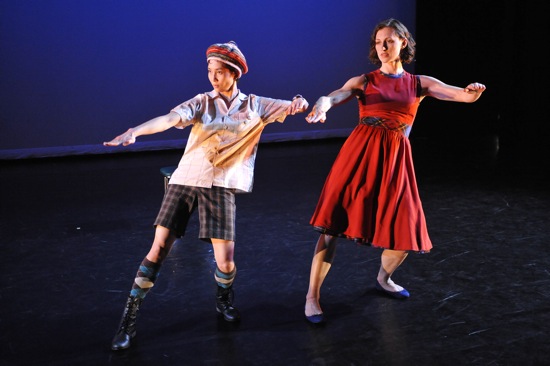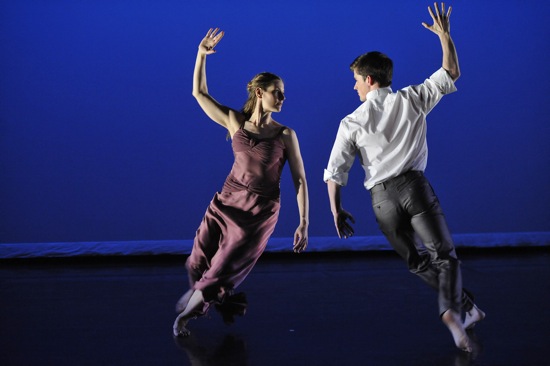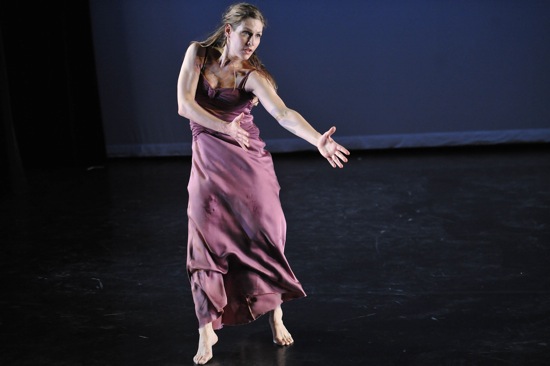Mark Morris Dance Group. James and Martha Duffy Performance Space, Mark Morris Dance Center, Brooklyn, New York. April 3 through 14.
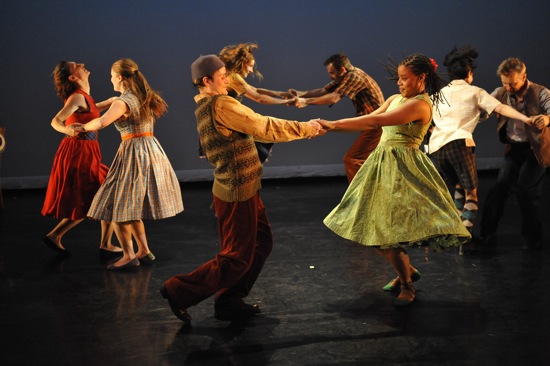
Mark Morris’s A Wooden Tree. (L to R):
Amber Star Merkens, Rita Donahue, Dallas McMurray, Jenn Weddel, Aaron Loux, Michelle Yard, Maile Okamura, Mikhail Baryshnikov. Photo: Stephanie Berger
You can’t predict much about a dance by Mark Morris. There’s no doubt that he responds to music and —with love and respect—choreographs that response into what he hears. He acknowledges with great sensitivity a composer’s tempi and structures and atmosphere, but you never know what else the sounds will trigger.
Antonin Dvorák’s Bagatelles for two violins, cello, and harmonium, Op. 47 (1878) inspired him to present a drab waiting room into which a woman with a clipboard intermittently walks to summon one of the six assembled people to leave the stage and come with her (The Office). Carl Maria von Weber’s Grand Duo Concertant, for clarinet and piano, Op. 48 (1814-1815) leads to his new Crosswalk’s racing traffic, collisions, and intersections by eight men and three women (the latter costumed in orange dresses that evoke traffic cones).
You might guess that Morris would cast Henry Cowell’s Suite for Violin and Piano (1925) as a duet, but not that the man in Jenn and Spencer (another world premiere) would be dressed in trousers and a dress shirt with its sleeves rolled up, while his partner and antagonist would wear a loose-fitting lavender evening gown, so long that it grazes the floor, and indulge in complications not usually embarked on in such attire.
Ivor Cutler (1923-2006), the Scottish composer, singer, and humorist, wrote songs—both childlike and astutely ironic—that have an English-music-hall sound, but laconic lyrics that undercut climaxes right and left. As is often Morris’s wont when dealing with vocal music, his choreography for A Wooden Tree (a New York premiere) fits gestures to Cutler’s words, but rarely in a completely predictable way. Were that even possible.
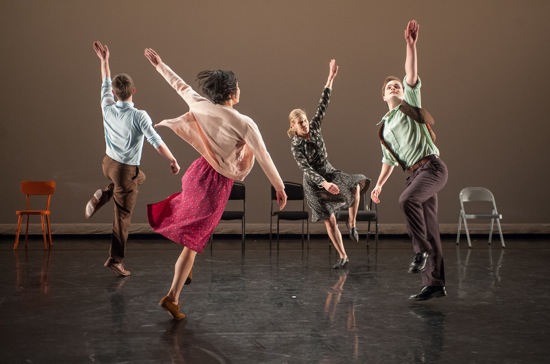
The Office: (L to R) Spencer Ramirez, Maile Okamura, Jenn Weddel, Dallas McMurray. Photo: Stephanie Berger
The Office (1994), which opens the program, is an enigma; it’s full of robust dancing that stamps and twists and chains its way through the hinted-at Czech melodies and rhythms in the five sections of Dvorák’s Bagatelles, but this little society that Morris has created is gradually shrinking. There are hard-backed chairs in the antechamber to who knows what. The people who sit on them wear unfashionable everyday clothing (by former company dancer June Omura). They don’t look citified like Laurel Lynch, the doorkeeper; she’s dressed in a dark, tailored suit and sensible shoes. She could be inviting people, one by one, to a job interview; or they could be waiting to be transported, re-assigned, questioned for evidence. None looks happy at leaving, but neither does anyone fight the seemingly inevitable departure; few look back.
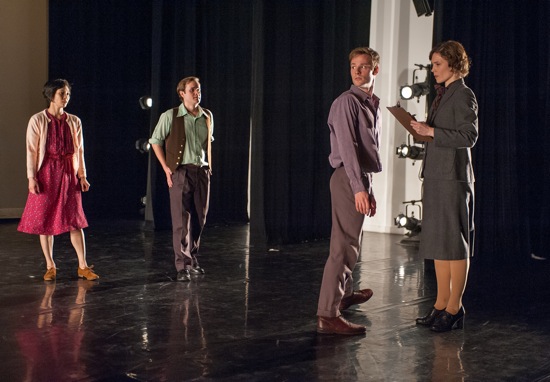
The Office: (L to R) Maile Okamura, Dallas McMurray, Billy Smith, Laurel Lynch. Photo: Stephanie Berger
Morris works with simple means—folk-dance steps given a pleasing twist and pulled into varying patterns—and he skillfully and sensitively tailors the ambiance of each section to the remaining number of people. Chelsea Lynn Acree is the first to leave, after which Dallas McMurray, Spencer Ramirez, and Billy Smith step in counterpoint to Maile Okamura and Jenn Weddel. When Smith is summoned, the remaining four form a square and energetically change places across it. At this point, the “Allegretto scherzando,” which has started out like the opening movement of the same name, asserts its difference. The musicians (Georgy Valtchev and Maxim Moston, violins; Andrew Janss, cello; and Colin Fowler, harmonium) suddenly seem to bear down on the melody, and the dancers’ stances get wider and their shoes strike the floor more emphatically.
When Weddel leaves, and Dvorák’s “Canon: andante con moto” starts, Okamura and McMurray form a counterpoint to Ramirez. No matter how few people are left, they always find ways to join hands and form a chain. They dance as if they never want to forget these steps, or one another. Okamura and McMurray seem happy in the final “Poco allegro,” but shortly before its final vigorous moments, the melody that opened the Suite reasserts itself in a mournful guise, and, when the music ends, Okamura is sitting alone in the silence, with five empty chairs and no hand to hold.
Since Ivor Cutler himself favored deerstalker hats and plaids, costumer Elizabeth Kurtzman has concocted a loony assemblage of Scottish outfits for A Wooden Tree. For instance, while Michelle Yard and some of the other women wear solid-color cotton dresses, Okamura sports long plaid shorts, a short-sleeved white shirt, knee-high argyle socks, and a tam o’shanter. Cutler sings his minimally melodic songs accompanied by a harmonium (an intriguingly subtle link with the Dvorák score that accompanied the preceding dance).
Morris finds ways to enlarge and undercut the very specific images. In “Rubber Toy,” when Cutler’s deep, slightly rough voice rhymes “lips” with “pips,” Mikhail Baryshnikov (guest artist as one of the gang) opens Okamura’s mouth (she’s the toy), and mimes spitting seeds into it. But when these, we’re told, sprout into a forest of girls, a lusty group makes a tableau of foliage. In “Little Black Buzzer,” the singer complains that he’s lost at the top of the world with a cold bum and a white face, trying to get a message to the outside world. Baryshnikov sits on the floor beside a chair and, with remarkable clarity, taps Morse code on its seat in counterpoint to the music, while the five women in the piece circle him, stepping jerkily in a dot-dash rhythm.
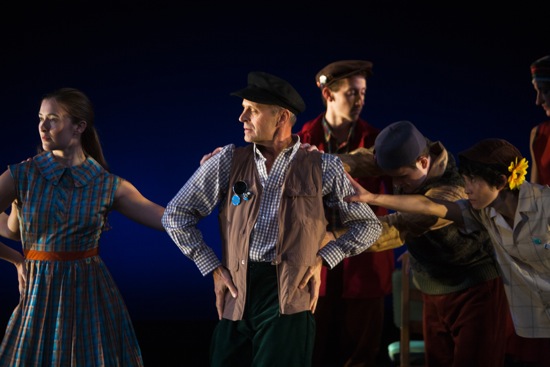
A Wooden Tree: Rita Donohue and Mikhail Baryshnikov (foreground) and (L to R) Aaron Loux, Dallas McMurray, Maile Okamura, and (half hidden) Amber Star Merkens. Photo: Stephanie Berger
Needless to say, Baryshikov immerses himself with verve in this community. His performance skills enable him both to fit in and to draw your eye. He’s a virtuoso of modesty—never more so when he and Weddel sit on chairs facing each other for “Beautiful Cosmos” to portray a long-married couple, companionably drinking tea, with little to say.
A Wooden Tree contains much interesting byplay on the sidelines, and the dancers (the cast includes Rita Donohue, Aaron Loux, and Amber Star Merkens) are as tartly and endearingly eccentric as the music.
Morris pulls a little joke of his own. After the poignant chair duet, Michael Chybowski dims his excellent lighting, the audience applauds, and the cast takes a bow. Then: Music! Lights! And a finale: “Cockadoodledon’t.”
If you listen to Cowell’s Suite for Violin and Piano after seeing Jenn and Spencer, you may find yourself thinking of the instruments as two beings who echo each other, argue, pose questions and provide answers, and embrace in ways both calming and disruptive. That Valtchev and Fowler will make provocative and lovely music together on their instrument is, of course, a given, just as it’s a given that Jenn Weddel and Spencer Ramirez—who’ve lent their names to the title— will reveal themselves as beautiful dancers, no matter what tensions Morris sets for them.
The tensions are many; so is the attraction between these two. When they circle the stage running, they never take their eyes off each other. And they contend in stranger, more intimate ways than simply pulling their grasped hands apart or striving to push an opponent away. Once, in the opening “Largo,” they lie on the floor, flailing until the soles of their feet meet and scrub against one another’s (the piano chords suddenly seem to be saying “no, no, no”). Then the two slide together, legs apart, until, for a tangled second or two, their crotches are locked as firmly as homing jigsaw-puzzle pieces.
Throughout the duet’s five sections, Ramirez and Weddel occasionally leave the arena, but never for long. They have moments alone to assert themselves. The couplings they create in the “Andante tranquillo” can seem idealized (he lies on his back, legs in the air; she lies on his upturned feet and swims in air) or crudely erotic (he lies face down; she lies on top of him; he sharply bends his knees, thrusting his lower legs ceiling-ward through the space between hers). Shortly after this, he crawls on his belly toward a downstage corner, and she accompanies him on foot—stepping back and forth over him, whipping one leg around each time, the arc of her satin skirt as threatening as a storm cloud in a wind.
The “Andante calmato” sounds anything but calm. The piano begins with a rumble of dark chords, and at first Weddel and Ramirez walk staggeringly, joltingly. In the duet’s most violent moment, he bends and grabs one of her ankles while she’s lying on the ground, then revolves, turning her by that leg so that she has to keep rolling; for several long, uncomfortable seconds, she looks like a snagged fish flipping at the end of a line. The final “Presto” ends with her smacking him. He falls. She exits.
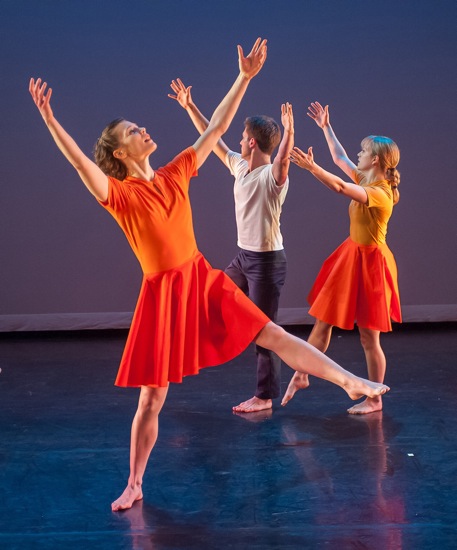
L to R: Laurel Lynch, Noah Vinson, and Chelsea Lynn Acree in Morris’s Crosswalk. Photo: Stephanie Berger
Jenn and Spencer is the dark heart of the evening. The closing piece, Crosswalk, announces itself from the get-go as mostly fleet, boisterous, and busy—like Weber’s Grand Duo Concertante, for which Todd Palmer matches his clarinet to Fowler’s expert piano playing. What can you expect from the opening image? Dancers face in various directions, crouched in on-your-mark positions, ready to launch themselves into dangerous terrain. The very first rush spins Lynch and knocks her to the floor.
This is a crowd scene. It involves the four men we’ve seen earlier in the evening, plus Samuel Black, Brian Lawson, Noah Vinson, and apprentice Benjamin Freedman. Countering or joining this octet are Acree, Lynch, and Stacy Martorana. The splendid dancers race, somersault, skip, walk in opposing directions, and vault into the air to beat their legs together. Traffic control (i.e. choreography) works very well. Pairs unfettered by gender distinctions collaborate to lift a third person, who legs drawn up, seems to be jumping a barrier (or just jumping for the pleasure of it). You think the trios may collide, but they don’t.
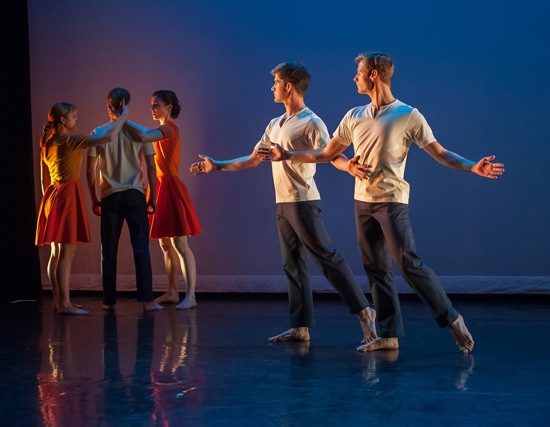
Crosswalk: (L to R) Chelsea Lynn Acree, Noah Vinson, Laurel Lynch, Spencer Ramirez, and Billy Smith. Photo: Stephanie Berger
There are some odd vignettes. During von Weber’s “Andante con Moto,” while some cast members pair up and stroll with the piano’s chords—not touching, but keeping close together, their crossed arms held out—Acree and Lynch decide to grab Vinson and yank him in two. Then they clasp his head and stroke the backs of his legs. He turns the tables though. Suddenly the two women are close together, walking on their hands and feet, as ungainly and out of step with each other as two straggling cows being urged along (my favorite moment). Vinson’s the momentary herder. Pretty soon you can’t tell for sure who’s controlling whom, let alone why. I think he dies.
But he’s not too dead to sit up when he hears the final “Rondo:Allegro.” All he needed was that green light. The leaping and rushing accelerates. Pairs form and un-form and reform. At a climactic moment, Lynch assembles the men, backs off and races toward them; she jumps, is tossed high, caught, and sent on her way. Finally someone yells “Go!” As if that isn’t what they’ve been doing all along.

